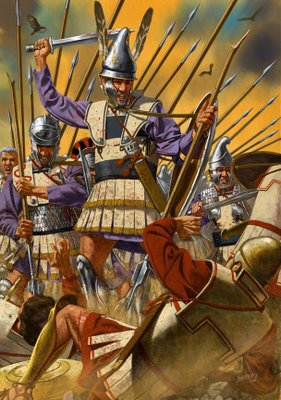Johnny Shumate illustrations
In Alexander’s army, the Argyraspides (“Silver Shields”) were its most effective and ferocious component. Under Eumenes they were invincible and enjoyed a legendary reputation. The unit was broken up and largely dispersed by Antigonus, but the name had its attractions. It was adopted by the shock troops of the Seleucid armies, who served as the royal infantry, recruited as the elite of the army. They will have been set on justifying the expectations inherent in the name. Regimental pride was (and is) a powerful motive force, and the Argyraspides will have ensured that their nomenclature was instantly familiar.
The term argyraspides (`silver shields’) first appears as an alternative title for the hypaspistai at the Battle of Gaugamela (331) in Diodorus 17.57.2 and Curtius 4.13.27. Justin 12.7.5 (cf. Curt. 8.5.4) tells us that before the Indian campaign Alexander had the men’s arms overlaid with silver and he called the army the argyraspides after their silver shields, so the change in regimental title came, in fact, later. At Opis in 324 we first of all have mention of hypaspistai (Arr. 7.8.3); then Alexander is mentioned as having created a taxis of Persian argyraspides (Arr. 7.11.3). These same Persians, 1,000 in number, are called hypaspistai by Diodorus (17.110.1). At this stage, then, it seems that the two terms were still used interchangeably for the same regiment.
After the death of Alexander the argyraspides, commanded by Antigenes and Teutamus (Plut., Eumenes 13.2) are given the strength of 3,000 (Diod. 18.58.1, 59.3). Antigenes is first mentioned as a commander of the hypaspistai after the promotions of Sittacene in 331. It is mentioned that at the battle fought in Gabiene in 317 most of the argyraspides were aged 70 (Diod. 19.41.2, Plut., Eumenes 16.4), which would make them born about 387, and so aged 43 when the army crossed over to Asia in 334. This confirms that we are dealing with the same unit that changed its regimental title.
In the battle in Paraetacenae which took place in 317/6 between Eumenes and Antigonus, Eumenes stationed the Macedonian argyraspides, more than 3,000 in number, next to `the men from the hypaspistai’, more than 3,000, the whole force being commanded by Antigenes and Teutamus (Diod. 19.28.1, 40.3). It is evident from this passage that a new and numerically equivalent force of hypaspistai has been set up, which was quite separate from the argyraspides. It has been suggested that the Greek should be understood to mean that they are the sons of the hypaspistai, and further that these can be identified with the hypaspistai mentioned earlier as being disastrously defeated in Egypt in 321 under the command of Perdiccas (Diod. 18.33.6, 34.2). It has also been suggested that they are Asian recruits.
#
The situation in the Seleucid kingdom is less well understood. Seleucus had ended up with the ‘elite cavalry regiments of Alexander’s army: two Iranian regiments, the agema and Nisaeans, together with the Companions, as well as the Argyraspides or `silver-shields’. These units retained their regimental identities down to the second century. The phalanx seems to have been recruited from a class of `Macedonian’ citizens. These are presumably descendants of Macedonian troops settled in colonies in Asia. It has been argued that the Argyraspides was a permanently embodied regiment through which the young men passed for training. They were then placed in a reserve which formed the main body of the phalanx in time of war.
The Seleucid army contained the famous Argyraspides inherited from the army of Alexander the Great. These were presumably troops armed with the larger type of shield. A Seleucid regiment of Chalcaspides also features in the Daphnae parade in 166. The text of Polybius describing the parade is defective, and the text has been restored by Kaibel to make reference to a further Seleucid regiment of Chrysaspides `Gold-shields’, but the supporting evidence for this is flimsy. The Pontic army also included a regiment of Chalcaspides, who are described as advancing into battle with sarissas and locked shields (Plut. Sull. 16.7).
